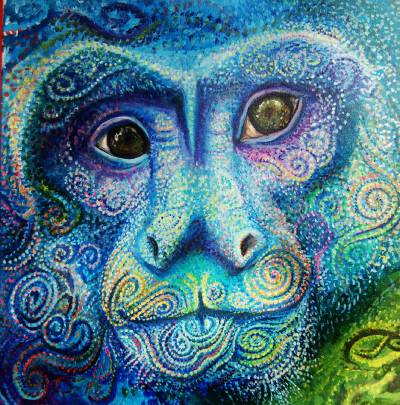Monkeys in Manuel Antonio are among the most fascinating and captivating creatures we encounter on our tours. There are four kinds of monkeys in Manuel Antonio National Park. These primates are not only a must-see for tourists, but they also help keep the park’s ecosystem healthy.

The four monkey species in Manuel Antonio National Park are the White-faced Capuchin, the Mantled Howler Monkey, the spider monkey, and the Central American Squirrel Monkey. Each species has unique characteristics and behavior patterns that make them fascinating to observe.
In this post you will find:
[ez-toc]
Where are the monkeys in Manuel Antonio?
You can see monkeys in Manuel Antonio almost everywhere. Particularly on the road to the National Park and in the forests that surround the hotels and AirBnBs on Espadilla Beach, as well as on the paths and beaches of Manuel Antonio National Park.
The White-faced Capuchin Monkey
The White-faced Capuchin Monkey is one of the most intelligent monkeys found in Central and South America. These monkeys are highly social and form groups of up to 20 individuals. They are omnivorous and eat a wide variety of foods, including fruits, insects, small animals, and even carrion. They are also known for their use of tools, such as using rocks to crack open nuts.

One of the most interesting aspects of the White-faced Capuchin Monkey’s behavior is their use of vocalizations. They have a wide range of calls that are used to communicate with each other, including alarm calls, food calls, and contact calls. Their vocalizations are so complex that researchers have identified over 40 different calls used by these monkeys.
They are frequently seen looking for food near where visitors to Manuel Antonio National Park stay, as well as around the area’s restaurants and hotels.
The Mantled Howler Monkey
The Mantled Howler Monkey is another species found in Manuel Antonio National Park. As the name suggests, these monkeys are known for their loud and distinctive vocalizations, which can be heard up to three miles away. The howling is used to communicate with other members of the group and to establish territorial boundaries.

Unlike the White-faced Capuchin Monkey, the Mantled Howler Monkey is primarily a folivore, which means they primarily eat leaves. They have a specialized digestive system that allows them to break down tough cellulose found in leaves. They also occasionally eat fruit and insects, but leaves make up the majority of their diet.
Central American Squirrel Monkey
The Central American Squirrel Monkey is the smallest monkey found in Manuel Antonio National Park. They are highly social and live in groups of up to 100 individuals. These monkeys are diurnal, which means they are active during the day, and their diet primarily consists of fruit and insects.

The sunbathing behavior of the Central American squirrel monkey is also well-known. These monkeys will spread out their arms and legs to absorb the warmth of the sun, and some researchers suggest that this behavior may be used to reduce the risk of vitamin D deficiency.
Spider Monkeys
These primates are known for their long, slender arms and prehensile tails, which they use to move through the forest canopy with incredible agility. Spider monkeys are primarily frugivores, meaning they primarily eat fruit. They have an important role in seed dispersal, as they eat fruit and then spread the seeds throughout the forest, helping to maintain the park’s biodiversity.

Spider monkeys are also highly social and live in groups of up to 35 individuals. Unfortunately, like the other monkey species in the park, they too are facing threats from human activity. It’s important for visitors to respect the monkeys’ space and avoid feeding them, as this can lead to aggressive behavior and health problems. Overall, spider monkeys are an important part of Manuel Antonio National Park’s ecosystem, and they are a very interesting species to watch.
The role of monkeys in Manuel Antonio
In addition to their fascinating behavior and characteristics, monkeys play an essential role in the ecosystem of Manuel Antonio National Park. As seed dispersers, monkeys help to maintain the balance of the forest ecosystem.
When monkeys eat fruit, they disperse seeds throughout the forest, allowing new plants to grow in areas that may not have had them before. This helps keep the forest’s diversity and makes sure that different kinds of plants and animals can live and grow.
Challenges of monkeys in Manuel Antonio
However, the presence of humans in the park has created some challenges for the monkeys. As visitors to the park have increased over the years, so have incidents of human-monkey interactions. Feeding monkeys is strictly prohibited in the park, as it can create a dependency on humans and lead to aggressive behavior towards visitors. It can also be bad for the monkeys’ health because they might get used to eating things that aren’t part of their natural diet.
To help protect the monkeys in Manuel Antonio National Park, it’s essential that visitors adhere to the park’s rules and regulations. This includes not feeding the monkeys, staying a safe distance away from them, and disposing of all trash properly to avoid attracting the monkeys to areas frequented by humans.
To Sum It Up
The White-faced Capuchin, the Mantled Howler Monkey, Spider Monkeys, and the Central American Squirrel Monkey each have unique characteristics and play a critical role in maintaining the balance of the forest ecosystem. When you see them in the wild, respect them, don’t get too close, do not feed them, and if you happen to be underneath them: keep your mouth closed.
If you want to see the monkeys in Manuel Antonio, or sloths and many other creatures, contact us, and we’ll make it happen!
This post was published first on https://epicadventurescr.com/monkeys-in-manuel-antonio-what-you-need-to-know-about-them/
